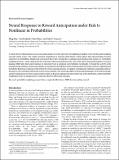Neural Response to Reward Anticipation under Risk Is Nonlinear in Probabilities
Author(s)
Hsu, Ming; Krajbich, Ian; Zhao, Chen; Camerer, Colin F.
DownloadHsu-2009-Neural Response to R.pdf (241.2Kb)
PUBLISHER_POLICY
Publisher Policy
Article is made available in accordance with the publisher's policy and may be subject to US copyright law. Please refer to the publisher's site for terms of use.
Terms of use
Metadata
Show full item recordAbstract
A widely observed phenomenon in decision making under risk is the apparent overweighting of unlikely events and the underweighting of nearly certain events. This violates standard assumptions in expected utility theory, which requires that expected utility be linear (objective) in probabilities. Models such as prospect theory have relaxed this assumption and introduced the notion of a “probability weighting function,” which captures the key properties found in experimental data. This study reports functional magnetic resonance imaging (fMRI) data that neural response to expected reward is nonlinear in probabilities. Specifically, we found that activity in the striatum during valuation of monetary gambles are nonlinear in probabilities in the pattern predicted by prospect theory, suggesting that probability distortion is reflected at the level of the reward encoding process. The degree of nonlinearity reflected in individual subjects' decisions is also correlated with striatal activity across subjects. Our results shed light on the neural mechanisms of reward processing, and have implications for future neuroscientific studies of decision making involving extreme tails of the distribution, where probability weighting provides an explanation for commonly observed behavioral anomalies.
Date issued
2009-02Department
Massachusetts Institute of Technology. Department of Electrical Engineering and Computer ScienceJournal
Journal of Neuroscience
Publisher
Society for Neuroscience
Citation
Hsu, Ming et al. “Neural Response to Reward Anticipation Under Risk Is Nonlinear in Probabilities.” The Journal of Neuroscience 29.7 (2009) : 2231 -2237. © 2009 by the Society for Neuroscience.
Version: Final published version
ISSN
0270-6474
1529-2401